| In 1992, the Canadian Forest
Service of Natural Resources Canada set up a network of 11
model forests across Canada. The objective of the network
is to find innovative methods for involving all users in sustainable
forest management. The Canadian Forest Service provides substantial
administrative support, technical expertise and a financial
contribution to the Canadian Model Forest Network. There are
two model forests in Quebec: the Waswanipi Cree Model Forest
and the Lower St. Lawrence Model Forest. In the fall of 1997,
the Canadian Forest Service–Laurentian Forestry Centre
(CFS–LFC) agreed to a Lower St. Lawrence Model Forest
request to design and implement a project that would evaluate
the socio-economic viability of forest tenant farming (see
sidebar), a management model that the Model Forest has been
testing since 1994. The highlights of the project are outlined
below.
 |
| EVALUATION
APPROACH |
| |
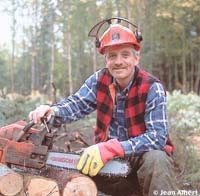
Carol Gagnon, tenant farmer. |
Upon completion of the project carried out under the supervision
of Sylvain Masse, the CFS–LFC released the evaluation
report "Socio-economic viability of forest tenant farming"
in September 2001. This evaluation was based on the following
four criteria: viability of the tenant farms, costs of general
supervision and technical support, socio-economic impact, and
potential for applying the model. For each of these criteria,
a series of indicators were assessed, mainly by means of three
surveys and one study. The first survey targeted active tenant
farmers; the second, former tenant farmers; and the third,
employees of tenant farmers. The study focussed on the costs
of general supervision and technical support.
 |
| RESULTS
OF THE THREE SURVEYS |
| |
The survey of active tenant farmers revealed that they were
generally satisfied with their working conditions and the
forest tenant farming operational framework. Most were also
satisfied with the income generated by their tenant farms,
and most foresaw an increase in their income over the next
five years. Their tenant farmer status also gave them non-financial
benefits. Many use the Model Forest lands for personal and
family recreational activities, particularly hunting, fishing
and hiking.
The active tenant farmers also said they had fulfilled their
two most important initial expectations concerning tenant
farming, which were to earn a decent living from the forest
while working year-round, and to be their own boss. All of
them want to continue being tenant farmers in the medium term
(five years) and most want to continue in the long term (15
years).
Figures relative to active tenant
farmers
| Number of tenant farmers at the time of
the survey |
25 |
| Average age |
39 years, same as for Quebec forestry workers |
| Average number of weeks worked in tenant farming operations
per year |
36 |
| Average net income from tenant farming before taxes |
$31,000 |
| Before becoming tenant farmers, two thirds
were already working in forest management |
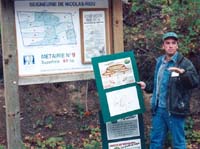
André Hins - Tenant farmer
at the Seigneurie Nicolas-Riou. |
The survey of former tenant farmers revealed that most agreed
with active tenant farmers about working conditions and the
non-financial benefits of tenant farming. They also had had
the same initial expectations. However, they were less satisfied
than active tenant farmers with the operational framework, particularly
in terms of outfitting and the technical support provided by
the Model Forest. Most former tenant farmers said their
tenant farms had not been very profitable due to insufficient
supplies of timber; they cite this lack of profitability as
the main reason for ending their experiment.
 |
 |
 |
| |
What is tenant
farming ?
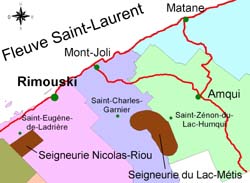 Tenant
farming is a land-lease model that originated in the
Middle Ages. According to the adapted model developed
and tested by the Lower St. Lawrence Model Forest,
the management of a unit of land, known as a tenant
farm, is assigned to an individual, known as a tenant
farmer, who agrees to manage it on a sustainable basis
and to share its income and harvest with the landowner.
The tenant farmer is therefore an entrepreneur, who
leases a unit of land in return for payment of stumpage
fees on the wood harvested. Tenant farmers are eligible
for subsidies under Quebec’s Financial Assistance
Program for the Development of Private Woodlots because
they are considered woodlot owners for the purposes
of this program. Tenant
farming is a land-lease model that originated in the
Middle Ages. According to the adapted model developed
and tested by the Lower St. Lawrence Model Forest,
the management of a unit of land, known as a tenant
farm, is assigned to an individual, known as a tenant
farmer, who agrees to manage it on a sustainable basis
and to share its income and harvest with the landowner.
The tenant farmer is therefore an entrepreneur, who
leases a unit of land in return for payment of stumpage
fees on the wood harvested. Tenant farmers are eligible
for subsidies under Quebec’s Financial Assistance
Program for the Development of Private Woodlots because
they are considered woodlot owners for the purposes
of this program.
The model is being tested in two areas (Lac-Métis
and Nicolas-Riou Seigneuries) consisting of 47,600
hectares owned by Abitibi Consolidated Inc. In all,
25 tenant farms are in operation, each with an average
area of 1,000 hectares and an average allowable cut
of 1,600 solid cubic metres per year. There are 16
tenant farms in the Seigneurie du Lac-Métis
and 9 in the Seigneurie Nicolas-Riou.
Forest planning in each seigneurie is based on a
multi-resource management plan prepared in cooperation
with the promoters and partners of the Model Forest.
The lands are divided into four allocation areas:
a resource conservation area, an environmental resource
protection area, a third area managed on the basis
of site characteristics, and a forest management area
with extensive recreational activities.
In addition, although tenant farmers manage their
tenant farms individually for timber production purposes,
they collectively manage recreational, hunting and
fishing activities through a tenant farmers’
outfitting operation in each seigneurie.
The Model Forest also provides tenant farmers with
general supervision and technical support. The technical
support team acts as the delivery agent for the regional
agency responsible for private woodlot development.

Recreational activities at the Lower St. Lawrence
Model Forest.
|
|
 |
 |
 |

Shelterwood cutting. |
Most employees of tenant farmers expressed satisfaction with
their job. They particularly like the opportunity to work
close to home, the relationship with their employer, the work
safety level and training opportunities provided for them.
Generally, they find their job more interesting than other
forestry jobs available in their region. Most of them plan
to continue working for tenant farmers in the next five years.
Figures relative to employees of tenant
farmers
| Number of employees in tenant farms |
Average age |
Average number of weeks worked in tenant farming
operations |
Average weekly earnings |
| 63 |
40 |
12 |
$485 |
 |
| STUDY
OF GENERAL SUPERVISION AND TECHNICAL SUPPORT COSTS |
| |
Case studies were used to compare the costs of general supervision
and technical support of forest tenant farming with three
other models used in Quebec to manage medium and large-scale
forest lands, i.e., the forestry group venture, the Timber
Supply and Forest Management Agreement (TSFMA) on Crown forests,
and the management of large private forests by forestry companies.
The comparison revealed that the costs of general supervision
of tenant farming were similar to those of large private forests
and forestry group ventures, but higher than the costs of
the TSFMA model.
The study focussed on the costs of technical support for
silvicultural activities. The results (see following table)
show that tenant farming costs are similar to those of forestry
group ventures and, in the case of commercial silviculture,
to those of large private forests. TSFMA technical support
costs were clearly lower, i.e., 70% less than the costs related
to tenant farming and forestry group ventures.
Annual costs of technical support
for silviculture, in dollars per hectare of work
| Model and period
|
Non-commercial silviculture* |
Commercial silviculture |
| Forest tenant farms, 1999-2000 |
$127 |
$127 |
| Forestry group ventures, 1995-1998 |
$138 |
$140 |
| Large private forests, 1996-1998 |
$75 |
$110 |
| TSFMA, 1996-1998 |
$34 |
$42 |
*Non-commercial silviculture refers to
work, such as reforestation and pre-commercial
thinning, that does not involve the harvesting of merchantable
timber.
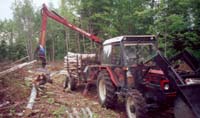
Hauling operation at the Seigneurie
Nicolas-Riou. |
Technical support costs for tenant farming multi-resource activities
were also significant, amounting to a quarter of all technical
support expenditures for this management model. However, the
study did not compare the costs of this technical support component
with similar components of other management models. The
overall general supervision and technical support costs of
tenant farming are comparable to those of the forestry group
venture. Both models have several characteristics in common,
particularly in terms of the level of mechanization of harvest
operations (manual felling and use of small forwarders), average
size of cutting areas (between 1.4 and 2.3 hectares), and
the operational and management support provided to woodlot
owners and tenant farmers.
 |
| OTHER
EVALUATION COMPONENTS |
| |
Sylvain Masse’s work also provides information on the
socio-economic impact of forest tenant farming, its viability,
and the potential for implementing the model elsewhere in
Quebec and Canada.
Impact on the local and regional economy
In 1998, forest tenant farmers hired 63 employees, who worked
an average of 12 weeks in forest tenant farming operations.
Forest tenant farmers also hired 36 local and regional businesses
to carry out work on forest tenant farms. In all, forest tenant
farms generated about 1,900 weeks of work for forest tenant
farmers, their employees and contractors.

Sign at the entrance of the Seigneurie
Nicolas-Riou. |
Most of the money allocated to operating expenses (fuel, supplies,
equipment rental, insurance, etc.) and to household expenses
by tenant farmers and their employees was spent in the local
and regional area. There were also economic benefits
related to the processing of some 40,000 solid cubic metres
of wood harvested each year by forest tenant farmers. Overall,
more than 95% of the wood harvested on forest farms was processed
in the Lower St. Lawrence region.
Another socio-economic impact of forest tenant farming was
significant savings (almost $165,000 per year) in employment
insurance benefits.
Forest tenant farms as viable businesses
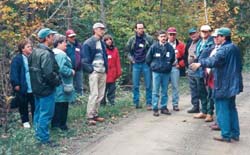
Open house for partners. |
The surveys of active and former tenant farmers made it possible
to gather a variety of information on the viability of forest
tenant farms. As mentioned above, forest tenant farmers were
generally satisfied with the net income generated by their tenant
farm, and most foresaw an increase in their income. Similarly,
their intention to remain tenant farmers in the medium term
and, for most of them, in the long term, is in itself an overall
indicator of viability. Moreover, all of the former tenant farmers
who were interviewed felt that most tenant farms would be viable
businesses in the medium term. However, the profitability
of forest tenant farms raises some issues such as the management
of non-timber activities. None of the tenant farmers whose
initial expectations had included multi-resource management
had yet fulfilled this goal. Similarly, the medium-term expectations
of tenant farmers in terms of income derived from non-timber
activities are now lower than they were at the beginning of
the project. Given these circumstances, timber production
will remain the main source of income for tenant farms in
the medium term and, consequently, the income level of tenant
farms will remain sensitive to timber market fluctuations.
Forest tenant farms throughout Quebec?
Thus far, many people have expressed an interest in becoming
tenant farmers. During the initial recruitment campaign in
1994, the Model Forest received 346 applications from Quebec
and other provinces for 27 available tenant farmer positions.
In 1998, a call for applications limited to the Lower St.
Lawrence region produced 105 applications for five positions.
A survey of 439 Lower St. Lawrence forestry workers1 conducted
in late 1996 and early 1997 revealed that 9% of respondents
wanted to become tenant farmers and that 21% were interested
in becoming forest farmers. It should be noted that for most
people interested in becoming forest farmers, tenant farming
is a way of circumventing the prohibitive cost of acquiring
enough land on which to make a year-round living.
In addition, all of the active and former tenant farmers
who were interviewed thought that the forest tenant farm model
could be implemented in places other than the Model Forest.
Nearly all of them thought the model would be used elsewhere
on public lands, particularly near municipalities. It should
be mentioned that most forested areas in Quebec that are large
enough to set up tenant farming communities are in the public
domain. Respondents expressed a preference for lands located
close to communities because of the advantages of working
close to home and because, as residents of local communities,
they felt an attachment to the surrounding area.
 |
 |
 |
| |
Two model forests
in Quebec
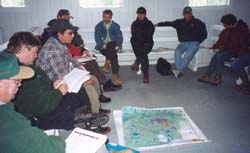 Two
of the 11 model forests in the Canadian network are
located in Quebec, including Canada’s only Aboriginal
Model Forest, the Waswanipi Cree Model Forest. The other
is the Lower St. Lawrence Model Forest, the testing
ground for both the forest tenant farming model and
a management strategy for improving group management
of private woodlot areas. Two
of the 11 model forests in the Canadian network are
located in Quebec, including Canada’s only Aboriginal
Model Forest, the Waswanipi Cree Model Forest. The other
is the Lower St. Lawrence Model Forest, the testing
ground for both the forest tenant farming model and
a management strategy for improving group management
of private woodlot areas.
Waswanipi Cree Model Forest (WCMF)
Covering an area of 209,600 hectares of boreal forest
in Northern Quebec, the Waswanipi Cree Model Forest
is the most recent model forest in the network. Its
guiding principle is to preserve and improve the forest
on the traditional Cree lands of Eeyoy Istchee in order
to generate benefits for Natives and all users. A management
strategy will be drawn up based on an assessment of
ancestral practices and on Cree knowledge and experience
in order to help the Cree preserve their way of life.
Lower St. Lawrence Model Forest
The lands of the Lower St. Lawrence Model Forest consist
of 113,000 hectares of mixed forest within rural municipalities
of the Lower St. Lawrence region. They are divided into
three separate sections, all of which are private lands:
the Nicolas-Riou and Lac-Métis Seigneuries, owned
by Abitibi Consolidated Inc. and where tenant farming
is being tested, and the area served by Groupement
forestier de l’Est du Lac Témiscouata
[Eastern Lake Témiscouata forestry group venture].
Maple, balsam fir and yellow birch stands cover most
of the area. |
|
 |
 |
 |
From this perspective, the forest tenant farming model offers
several advantages. For example, the model helps meet the
desirable objective of diversifying the types of land tenure
on public lands in order to respond to the diversity of contexts
associated with forest resources management. Another advantage
of tenant farming is its flexibility of application. The model
can take on various forms, depending on the context in which
it is applied. Various options for implementing the model
depend on the type of land tenure (public or private), the
type rights granted to tenant farmers (timber resources, maple
syrup production, wildlife, etc.), and the structure of the
tenant farmer community (cooperative, etc.).
The forest tenant farming concept already exist and other
projects are currently being developed. In the spring of 2000,
Maibec Industries announced it was setting up a tenant farm
in blocks of lots it owns in the counties of L’Islet,
Montmagny and Bellechasse. This initiative includes timber
and maple syrup production, an outfitting operation and an
inn. Other projects are also being studied, particularly in
the Abitibi-Témiscamingue region and outside Quebec.
 |
| CONCLUSION |
| |
The results for each of the four evaluation criteria outlined
above may be summarized as follows:
- Forest tenant farms are viable businesses whose main
source of income in the medium term will remain timber production.
- General supervision and technical support costs are similar
to those of forestry group ventures.
- Forest tenant farming generates tangible socio-economic
benefits, primarily at the local and regional level.
- The model has good potential for use elsewhere, particularly
in Crown forests located near municipalities.
However, there are a number of challenges involved in testing
and extending the model, particularly in terms of group management
of non-timber activities and the sensitivity of tenant farm
income to timber market fluctuations.
Based on these overall results, it may be concluded that
forest tenant farming is socio-economically viable, as tested
in the Lower St. Lawrence Model Forest. However, only the
establishment of tenant farms in a variety of contexts will
make it possible to determine the potential for extending
the model.
|